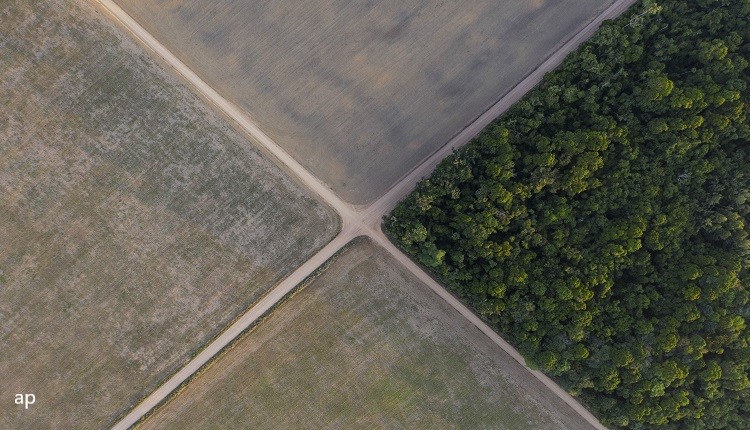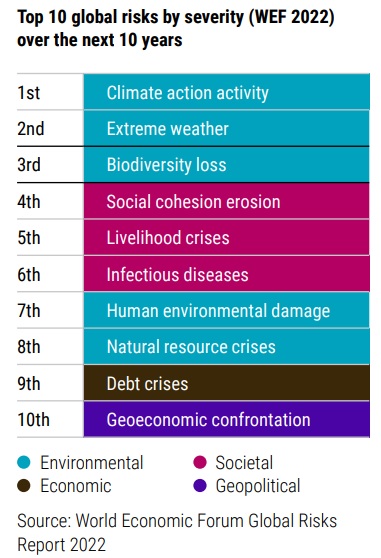
Biodiversity is defined as the variety of all life forms on Earth. It includes the number of species, their genetic variation and the interaction of these living forms within complex ecosystems.
Healthy ecosystems provide us with essential things that we take for granted: for example, plants convert energy from the sun, making it available to other life forms. Bacteria and other living organisms break down organic matter into nutrients that provide plants with healthy soil in which to grow.
According to the World Economic Forum, half of the world's GDP, around $44 trillion, depends on nature and healthy ecosystems. Preserving marine and terrestrial biodiversity is therefore essential for the life of the planet and all living things.
To date, 75% of the world's natural ecosystems have been damaged by human activities and the increase in the world population will only worsen this situation. And in a UN report published in 2019, scientists predicted the possible extinction of one million species (out of an estimated eight million), many of which risk disappearing within a few decades. Some researchers even believe that we are facing the sixth mass extinction in the history of planet Earth.
What the Finance Sector Can Do
A reckoning is due for industries that are damaging biodiversity, argues Thijs Huurdeman, ESG Research Manager at Morningstar Sustainalytics.
“Reality will continue to catch up to the investor community; those investors that are heavily invested in companies that are highly exposed to biodiversity related risks will at some point see their risk exposure materialise in financial pain,”
“Think for example of companies in the food sector. Here the risk really is a double-edged sword: regulators and/or consumer demand will curtail companies regarding their activities that harm biodiversity, such as excessive use of fertilizers and pesticides, deforestation for land use change. But a loss of biodiversity will by itself cause a loss of productivity, as our global food system is depending on healthy soils, pollination and other ecosystems services to provide us with food. Loss of biodiversity leads to a loss nature’s productivity, which our food system is dependent on.”
Events such as COP15 – the UN biodiversity summit held in Montreal last December - are crucial, but not conclusive. “The financial sector must play a more active role,” writes Laurent Ramsey, Managing Partner at the Pictet Group in a note. “Managing large amounts of capital on a global scale, the financial sector is in an important position to help build an economy that works with (rather than against) nature. Finance can facilitate a positive transition for nature by transforming the way it allocates capital to businesses and developing new models to more accurately assess biodiversity-related risks and opportunities.”
For example, the Finance to Revive Biodiversity (FinBio) programme, in which Pictet is a partner under the supervision of Stockholm University’s Resilience Centre, aims to develop research in support of the financial sector, aimed at transforming current practices (which reward growth, often at the expense of biodiversity) into new models, capable of analysing and assigning an economic value to the characteristics of a company, in relation to nature.
Investment opportunities in biodiversity are essentially based on three factors: demand, regulation and innovation. These activities can be very diverse but are generally united by innovation and technology. They include companies that practice planet-friendly agriculture, those that build environmentally sustainable urban spaces and those that create a more circular economy.
“Investors could approach biodiversity issues through a risk lens – how does loss of biodiversity impact the bottom line of the companies in my portfolio, directly or indirectly – or through an impact lens, where as an investor you focus on mitigating/eliminating negative impacts on biodiversity, or perhaps even aim for a net positive impact outcome on biodiversity,” explains Huurdeman.
“To find the best opportunities, we must first examine the real causes of biodiversity decline,” says a White Paper published by Switzerland’s UBP (Union Bancaire Privée). “Climate change and pollution, which destabilize ecosystems, are determining factors, as are deforestation and other land-use changes (especially for agriculture) that contribute to habitat loss, overexploitation of natural resources, the most obvious form of which is intensive fishing.”

Good Data is Key
The most complex challenge in this field is finding reliable data and shared standards. “For all impact investing strategies, obtaining standardised, audited non-financial data is a real challenge,” UBP's analysis continues. “This lack of data is compounded by the fact that there is no agreed method of measuring net biodiversity gain to determine progress.”
To be effective, we need an approach that is precise, systematic and replicable in different sectors and geographic areas, both by companies and investors. In the case of climate change, the volume of carbon emissions has been identified as the main factor to consider when measuring impact. In the case of biodiversity loss, however, the situation is much more complex, as it depends on a multitude of individual factors.
While it is easy enough for a manager or analyst to know how many trees were felled in a certain area over a certain time period, linking the impacts of biodiversity loss to the companies that felled them to identify the best investment opportunities is much more complex. In a global economy, it is also very difficult to know exactly what is happening throughout the supply chain to isolate where biodiversity violations occur.
Scrutinising the data providers to get the best possible analysis has been our focus with our academic partnerships for the last two years,” says Lucian Peppelenbos, Climate & Biodiversity Strategist at Robeco. “We have started to build an investment framework so that we can apply it across our portfolios and really link issuers to biodiversity impacts, identifying those companies that do better than the others.”
“We already have satellite-based real-time emission data, whereas for our portfolios, we are still using two-year-old data,” Peppelenbos says. “If you fast-forward two years, I think a lot of this kind of data will become available.”
So, pro-biodiversity investments in the universe of listed securities are still at an early stage, and there is no shortage of obstacles as well as opportunities.
In this sense, a first important step forward was taken at COP15 in December 2022, with the adoption of the Kunming-Montreal Global Biodiversity Framework (GBF), which provides a series of measures, controls and funding to halt and reverse biodiversity loss.
Funds and ETFs available in Europe
Asset managers, who play a central role through their capital allocation decisions, have realized that the achievement of Net Zero goals cannot be separated from the protection of biodiversity and that their task is to accompany companies towards the transition.
In recent times, the number of mutual funds and exchange traded funds that aim to offer investment solutions geared towards the preservation of biodiversity has therefore multiplied. According to Morningstar, there are currently 14 among those domiciled in Europe.
Apart from the pioneer fund PAM Europe Biodiversité C, launched in 2008 by French asset manager Pléiade (and distributed only in France), the other 13 were all launched after 2020 and in particular in 2022. In general, French asset managers seem to be the most active in this field. Indeed, among the companies that have launched at least one biodiversity fund. Besides Pléiade, we find AXA, Tocqueville, Financière de l'Echiquier, BNP Paribas, Ossiam/Natixis and Federal Finance Gestion.
Beware, however, that this is a very heterogeneous group of investment strategies. Indeed, portfolios can vary in terms of style and sector exposure, type of objectives pursued, and therefore the risk-return ratio can also be very different.
“In general I would say investors could focus those companies that have solid policies and programs on biodiversity and deforestation, and effective management systems to execute on those policies and programs”, says Morningstar Sustainalytics’ Huurdeman. “Proper supply chain due diligence is also key for those companies sourcing commodities that are linked to deforestation and loss of biodiversity (beef, palm oil, soy, and many others). In terms of business activities, investors could focus on companies involved in renewable energy, energy efficiencies, water savings, organic- or plant-based food production, and food innovations that require less land use, pesticides and fertilizers to produce food.”
In terms of assets under management, the biggest is the AXA IM ACT Biodiversity Equity UCITS ETF (ABIE), which is classified under the Article 8 of the SFDR. It is an actively managed ETF, which means that there is no specific benchmark, but it is manager Charles Lewandowski who selects a portfolio of stocks of companies active in the pursuit of the UN Sustainable Development Goals (SDGs), in particular those related to clean water and sanitation (Goal 6), responsible consumption and production (Goal 12), life under water (Goal 14) and life on Earth (Goal 15).
Among the most important stocks in the portfolio (85 names in total) are, for example, the American Ecolab (ECL), active in offering services, technologies and systems specialising in the treatment, purification, cleaning and hygiene of water in a wide variety of applications, or Agilent Technologies (A), a leading life sciences and diagnostics company.
Another actively managed ETF, the Ossiam Food for Biodiversity UCITS ETF Class 1A (F4DE), focuses on the agri-food sector. Stocks are weighted using an optimisation process that minimises the biodiversity impact of the portfolio (based on previous year's biodiversity impact data), while reducing total greenhouse gas emissions by 30 per cent.
Specialist analyst firm Iceberg Data Lab provides corporate biodiversity ratings, known as Corporate Biodiversity Footprints. Companies can increase their biodiversity score by improving their practices in one of four measured factors: carbon emissions, land use that takes valuable space away from natural habitats, soil acidification caused by nitrogen oxides in fertilisers, and freshwater pollution.
The portfolio consists of some 50 stocks, the main ones being food and restaurant giants such as Costco Wholesale (COST), Starbucks (SBUX), Nestlé (NESN) and Unilever (ULVR).
Remaining in the field of ETFs is the BNP Paribas Easy ESG Eurozone Biodiversity Leaders PAB UCITS ETF (BIODV), which also aims to align the investment theme of biodiversity with the emission reduction targets of the 2015 Paris Agreement. The fund replicates the Euronext ESG Eurozone Biodiversity Leaders PAB index, built from the universe of the parent index Euronext Eurozone 300, a broad representation of the 300 largest listed companies in developed market countries belonging to the single currency bloc. Iceberg Data Lab analyses are also used here.
Active Funds
Among the actively managed traditional open-end funds, the UBAM Biodiversity Restoration Fund of Union Bancaire Privée, for example, aims to identify and invest in those companies that protect and restore the planet's species and natural habitats through their products and supply chains. The fund invests in seven vertical themes, including sustainable natural resource management, green cities and sustainable food production. This strategy leans toward larger, more growth-focused companies compared with its average peer in the Global Small/Mid-Cap Equity Morningstar Category, and consistently held some companies with relatively lower trading volume. On the other side, the team has had a position favouring high-quality stocks in recent years, which could contribute to higher downside risk protection.
The biggest names of the portfolio (47 components in total) are world’s leading manufacturers of agricultural equipment Deere & Co (DE) and AGCO (AGCO), as well as Arcadis (ARCAD), the Amsterdam-based world’s leading company delivering sustainable design, engineering, and consultancy solutions for natural and built assets.




























